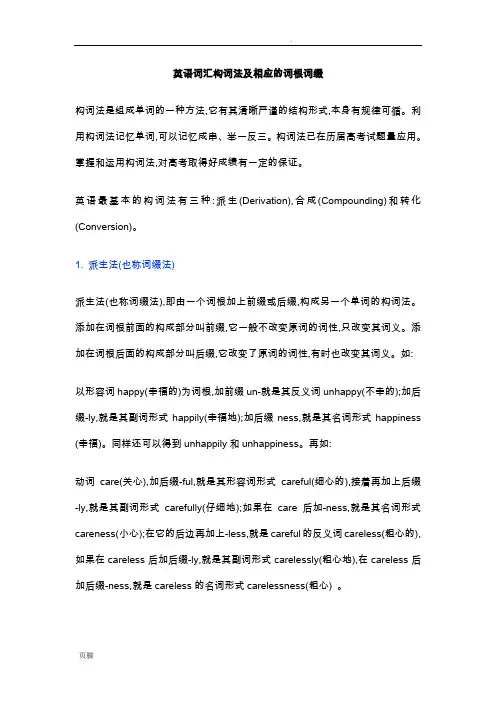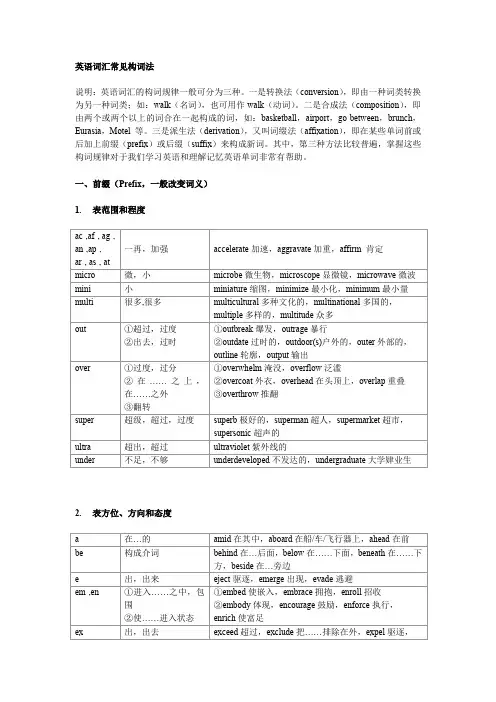词汇学之构词法
英语构词法(常用的词根词缀总结)

英语词汇构词法及相应的词根词缀构词法是组成单词的一种方法,它有其清晰严谨的结构形式,本身有规律可循。
利用构词法记忆单词,可以记忆成串、举一反三。
构词法已在历届高考试题量应用。
掌握和运用构词法,对高考取得好成绩有一定的保证。
英语最基本的构词法有三种:派生(Derivation),合成(Compounding)和转化(Conversion)。
1. 派生法(也称词缀法)派生法(也称词缀法),即由一个词根加上前缀或后缀,构成另一个单词的构词法。
添加在词根前面的构成部分叫前缀,它一般不改变原词的词性,只改变其词义。
添加在词根后面的构成部分叫后缀,它改变了原词的词性,有时也改变其词义。
如: 以形容词happy(幸福的)为词根,加前缀un-就是其反义词unhappy(不幸的);加后缀-ly,就是其副词形式happily(幸福地);加后缀ness,就是其名词形式happiness (幸福)。
同样还可以得到unhappily和unhappiness。
再如:动词care(关心),加后缀-ful,就是其形容词形式careful(细心的),接着再加上后缀-ly,就是其副词形式carefully(仔细地);如果在care后加-ness,就是其名词形式careness(小心);在它的后边再加上-less,就是careful的反义词careless(粗心的),如果在careless后加后缀-ly,就是其副词形式carelessly(粗心地),在careless后加后缀-ness,就是careless的名词形式carelessness(粗心) 。
前缀、后缀是构词的要素,具有一定的作用和意义。
懂得了前后缀的含义,就容易了解由前(后)缀和词根结合而成的单词的意义。
现把英语中我们常见的前后缀列举如下:1)前缀anti-反对: antisocial反社会的auto-自: automobile小汽车,autonomy自治bi-双: biannual 一年两次的, bicycle自行车by-在旁:bystander 旁观者, by-product副产品co- 同: co-operation合作,co-existence共处,co-worker同事counter-反:counter-attack反攻,counter-revolutionary反革命的dis-否定,除去: discover发现,disorder混乱,杂乱en-使成为: enable使能够,enslave奴役, encourage鼓励extra-外: extraordinary非常的,格外的for-,fore-,先,前,预: forward向前,foresee 预见,forearm前臂,foretaste先尝for-禁,弃: forbid禁止,forget忘记,forgo放弃in-,il-,im-,ir-不,非: informal非正式的,incomplete不完全的,indefinite不定的,illegal非法的,immoral不道德的,irregular不规则的inter-间,相互:internationalism国际主义,interview会见micro-微: microscope显微镜,microfilm微型胶片mid-中:midday 中午,midnight夜半,mid-autumn中秋的mis-误: misunderstand 误会,misuse误用,misfortune不幸non-非,不:non-moral非道德围的,nonsense胡言,nonexistent不存在的post-后于: postwar战后的pre-先于: prewar战前的re-重,再,复: rewrite重写, return返回, review复习super-上,超: superman超人,supermarket 超级商场tele-远: telephone,telescope望远镜,television电视un-不: unable不能的,unimportant不重要的,untrue不真实的vice-副:vice-chairman副主席,vice-premier副总理2)后缀-age状态,集合: marriage婚姻, shortage缺少,village 村庄-an人: American美国人,Italian意大利人,意大利籍,African 非洲人-ation,-ition动作,状态:determination决心,industrialization工业化,preparation 准备,competition竞争,repetition重复-dom状态,领界: freedom自由,kingdom王国-eer人: engineer工程师,volunteer志愿者-er人,动作者:fighter战士,worker工人,writer作家,thinker思想家,harvester收割机-ese人,语言:Chinese中国人,中文, Japanese日本人,日文-ess女性:actress女演员,princess公主,goddess女神-hood身分,境遇,状态: childhood 童年,womanhood女性-ian人: musician音乐家, guardian卫护者, Christian基督教徒-ism主义,教:communism共产主义,socialism社会主义,revisionism修正主义-ist主义者,人: communist共产主义者, artist 艺术家-ity (抽象名词): possibility 可能性, ability能力,equality平等-man人: Englishman英国人,英格兰人, postman邮递员-ment运动,结果: movement运动,development发展,judgement判断-ness状态,性质:kindness和善,carefulness小心,correctness正确,tiredness疲倦-or人,动作者: actor男演员,visitor访问者-ship状态,身份: friendship友谊,comradeship同志之友谊,sportsmanship 体育道德,hardship苦难-sion动作,状态: tension紧状态,revision修订-tion动作,状态: attention注意,action行动-less无:fearless 无所畏惧的,careless 不小心的,useless 无用的,meaningless 无意义的-ly品质,的: comradely 同志般的, friendly 友好的, weekly 每星期的-some引起,适于,易于: troublesome 烦人的,tiresome 令人感到厌倦的2. 合成法(也称复合法)把两个单词或两个以上的词合成一个新词,这种构词的方法叫做合成法。
词汇学之构词法共37页文档

31、只有永远躺在泥坑里的人,才不会再掉进坑里。——黑格尔 32、希望的灯一旦熄灭,生活刹那间变成了一片黑暗。——普列姆昌德 33、希望是人生的乳母。——科策布 34、形成天才的决定因素应该是勤奋。——郭沫若 35、学到很多东西的诀窍,就是一下子不要学很多。——洛克
词汇学之构词法
21、没有人陪你走一辈子,所以你要 适应孤 独,没 有人会 帮你一 辈子, 所以你 要奋斗 一生。 22、当眼泪流尽的时候,留下的应该 是坚强 。 23、要改变命运,首先改变自己。
24、勇气很有理由被当作人类德性之 首,因 为这种 德性保 证了所 有其余 的德性 。--温 斯顿. 丘吉尔 。 25、梯子的梯阶从来不是用来搁脚的 ,它只 是让人 们的脚 放上一 段时间 ,以便 让别一 只脚能 够再往 上登。
英语词汇学之构词法PPT课件

-en
woolen, golden, wooden, earthen…
-ent different, dependent, existent, consistent…
-ic
realistic, poetic, historic, economic…
November 18, 2023
14
常见后缀2—形容词后缀
11
常见后缀1—名词后缀
后缀 例词
-an
Asian, American, Russian, African…
-ance attendance, performance, assistance…
-ation education, examination, pronunciation…
-dom
freedom, kingdom, wisdom, boredom…
spy(监视)
lower(更低的) lower(降低)
1818
其它构词法之截短法
缺点
杂乱 不喜欢
10
常见前缀3—特定意思
构成方式
anti-(反) auto-(自动) bi-(双) centi-(百分之一的) co-(共同) down(向下) ex-(以前的) fore-(前部的) full-(完全) November 18, 2023
例词
antiwar, anticancer, antipollution… automatic, autotimer, auto-record… bicycle, binoculars… centimeter, centigram, centigrade… co-operate, co-edit, co-exit… downstairs, downhill, downwards… ex-wife, ex-lover, ex-husband… forehead, foreleg, forearm… full-time, full-speed, full-strength…
词汇学构词法clipping

例子
常见的截词法单词还有“bus”(代 表“omnibus”)、“copter” (代表“helicopter”)等。
首字母缩写(Acronym)
01
总结词
02
详细描述
首字母缩写是通过取单词的首字母而 形成新词的方法。
例如,“NASA”是“National Aeronautics and Space Administration”的首字母缩写。
缺点
语义不明确
由于Clipping构词法是通过截取原有词汇的一部分来构成新词,有时候会导致新词的语 义不明确,容易引发歧义和误解。
稳定性差
由于Clipping构词法产生的新词往往不稳定,随着时间的推移和语言的发展,有些新词 可能会逐渐被淘汰或被其他新词所取代。
不符合语法规则
有时候Clipping构词法产生的新词可能不符合语法规则,需要进行一定的调整和规范, 才能被广泛接受和使用。
04
Clipping构词法的优缺点
优点
简洁高效
Clipping构词法通过截取原有词汇的一部分来构成新词,使得新词 简洁明了,易于记忆和使用。
形象生动
Clipping构词法常常将原有词汇中最具代表性的部分截取出来,使 得新词形象生动,能够直观地表达概念或事物特征。
创新性强
Clipping构词法是一种创新性的构词方式,能够产生大量新颖的词 汇,满足语言发展的需要。
“International Phone”。
行业术语
某些行业内部使用的术语或缩写,如“IPO”代替“Initial Public Offering”,“GDP”代替“Gross Domestic Product”。
学术领域的应用
学科术语
常见英语构词法

英语词汇常见构词法
说明:英语词汇的构词规律一般可分为三种。
一是转换法(conversion),即由一种词类转换为另一种词类;如:walk(名词),也可用作walk(动词)。
二是合成法(composition),即由两个或两个以上的词合在一起构成的词,如:basketball,airport,go-between,brunch,Eurasia,Motel 等。
三是派生法(derivation),又叫词缀法(affixation),即在某些单词前或后加上前缀(prefix)或后缀(suffix)来构成新词。
其中,第三种方法比较普遍,掌握这些构词规律对于我们学习英语和理解记忆英语单词非常有帮助。
一、前缀(Prefix,一般改变词义)
1.表范围和程度
2.表方位、方向和态度
3.表否定
4.表逆反
5.表数字
6.表贬义
7.其他
二、后缀(Suffix,一般改变词性)
1.名词后缀
2.形容词后缀
3.动词后缀
4.副词后缀。
词汇学之构词法课件

目录
CONTENTS
• 构词法简介 • 前缀构词法 • 后缀构词法 • 合成词构词法 • 转化词构词法 • 总结与展望
01 构词法简介
什么是构词法
01
构词法是研究词汇变化和形成的 科学,它主要研究词素组合的方 式、词素替换的规则等。
02
构词法包括词根、前缀、后缀、 词尾等元素,这些元素可以组合 、替换、变化,形成新的词汇。
构词法的重要性
构词法是语言学中重要的分支学科, 它对于理解语言的形成和发展、词汇 的变化规律以及语言的实际应用都有 重要的意义。
通过学习构词法,可以更好地理解词 汇的构成和意义,提高语言表达能力 。
构词法的分类
合成法
派生法
将两个或多个词素组合在一起形成新词的 方法。例如,“bookstore”由“book” 和“store”组合而成。
特点
前缀构词法是一种相对简单且易于掌 握的构词方法,通过添加前缀可以快 速创造新词。
规律
限制
虽然前缀构词法可以创造大量新词, 但并不是所有词根都可以随意添加前 缀,需要考虑到语言的语法和语义规 则。
前缀构词法有一定的规律可循,如 “dis-”通常表示否定意义,“re-” 通常表示重复或再次。
03 后缀构词法
04 合成词构词法
合成词的定义与构成方式
合成词定义
由两个或两个以上的词素组合而成的词。
构成方式
通过不同的组合方式,如名词+动词、形容词+名词、副词+动词等,形成具有特 定意义的合成词。
常见英语合成词举例
名词+动词
bookcase(书架)、 playground(操场)
形容词+名词
英语单词构词法
英语的构词法主要有:
一、加词缀法(affixation)
加词缀法分为屈折变化法(inflexion)和派生法(derivation) 0
屈折变化法是指词尾有表示名词复数、格、第三人称单数、动词时态的后缀以及有表示形容词和副词比较级和最高级的后缀。
派生法是给词根添加上前缀或后缀而构词。
二、复合法(compound)
复合词大部分由两个自由词素构成。
三、缩合法(blending)
用两个或两个以上自由词素各自的一部分构成新词。
四、转化法(conversion)
1.名词转化为动词
2.动词转化为名词
3.形容词转化为动词
五、缩写法(abbreviation)
缩写法主要有下列六种:
1.缩略(clipping)
2.首字母缩略词(initialism)
3.省略(omission)
4.缩约(contraction)
5.替换(substitution)
具体方法如下:。
词汇构词法现代汉语
词汇构词法现代汉语现代汉语词汇构词法学习资料。
一、构词法概述。
1. 定义。
- 构词法是指语素构成词的方法。
在现代汉语中,词是能够独立运用的最小语言单位,而语素是最小的音义结合体。
例如“天”是一个语素,它有自己的读音(tiān)和意义(天空),当“天”单独使用时,它就是一个词;当它和其他语素组合,如“天空”(tiān kōng),这里就涉及到构词法的问题。
2. 构词法的意义。
- 有助于我们理解词的结构和意义的形成。
通过分析构词法,我们可以更好地掌握词汇,提高语言运用能力,如在辨析近义词、反义词,以及理解一些新产生的词语时,构词法知识都很有用。
二、构词类型。
(一)单纯词。
1. 定义及发音示例。
- 单纯词是由一个语素构成的词。
这个语素有的是单音节的,如“天(tiān)”“地(dì)”,它们既是语素也是词,词性根据具体语境而定,“天”“地”在“蓝天(lán tiān)”“大地(dà dì)”中都是名词。
- 还有多音节的单纯词,包括连绵词、音译词等。
- 连绵词:- 双声连绵词,如“仿佛(fǎng fú)”,两个音节的声母相同,“仿佛”是副词,表示似乎、好像的意思。
- 叠韵连绵词,像“朦胧(méng lóng)”,两个音节的韵母相同,“朦胧”是形容词,形容模糊不清的样子。
- 音译词:例如“咖啡(kā fēi)”,这是一个名词,是从外语音译过来的单纯词。
(二)合成词。
1. 复合式。
- 联合型(并列型)- 定义及示例:由两个意义相同、相近、相反或相关的语素并列组合而成。
例如“国家(guó jiā)”,“国”和“家”意义相近,都是名词,组合成“国家”后仍然是名词。
再如“开关(kāi guān)”,“开”和“关”意义相反,“开关”是名词,表示一种电器装置。
- 偏正型。
- 定义及示例:前一个语素修饰、限制后一个语素。
如“火车(huǒ chē)”,“火”修饰“车”,表示以火为动力的车,“火车”是名词。
英语词汇学之构词法
Example
"self confidence" is a compound objective formed from the words "self" and "confidence"
Example
"upload" is a compound verb formed from the words "up" and "load"
Other examples
"download", "email", "Google"
Verb synthesis
Objective synthesis
ቤተ መጻሕፍቲ ባይዱ
Transforming verbs into nouns
Verb to noun transformation: In English, it is also common for verbs to transform into nouns This process is called conversion or zero differentiation For example, the verb "to run" can be transformed into the noun "run," which can refer to a single act of running or a race Other examples include "to jump" (from "leap"), "to swim" (from "swim"), and "to write" (from "script")
英语词汇构词法
英语词汇构词法(Word-formation)英语构词通常包括六种方法:转化法、派生法、合成法、混合法、截短法和首尾字母结合法。
一、英语词汇构词法之【转化法】英语构词法中把一种词性用作另一种词性而词形不变的方法叫作转化法,有的名词可以作动词,有的形容词可以作副词或动词。
1.动词转化为名词1)意思没有变化,例如:I think we'd better finish the talk now.我想我们的谈话最好现在结束。
2)意思有一定变化,例如:He is a man of strong build.他是一个体格健壮的汉子。
3)构成短语,例如:Let's have a look first. 我们先看一下吧。
2.名词转化为动词1)表示物体的,如:Have you booked the ticket?你订好票了吗?2)表示身体部位的,如:Hand in your papers please.请把你们的试卷交上来。
3)表示一类人的,如:She nursed her husband back to health.她看护丈夫,使他恢复了健康。
4)抽象名词,如:We breakfasted together.我们在一起吃了早餐。
3.形容词转化为动词少数形容词可以转化为动词。
例如:We will try our best to better our living conditions.我们要尽力改善我们的生活状况。
4.副词转化为动词有少数副词可以转化为动词。
例如:Murder will out.恶事终必将败露。
5.形容词转化为名词1)表示颜色的形容词常可转化为名词,如:The girl in black appears very beautiful.那个穿黑衣服的女孩子看上去非常漂亮。
2)一些形容词如old, young, poor, rich, wounded, injured等与the连用,表示一类人,作主语时,谓语用复数,如:We don't belong to the rich, but we don't belong to the poor, either. 我们不是有钱人,但我们也不是穷人。
- 1、下载文档前请自行甄别文档内容的完整性,平台不提供额外的编辑、内容补充、找答案等附加服务。
- 2、"仅部分预览"的文档,不可在线预览部分如存在完整性等问题,可反馈申请退款(可完整预览的文档不适用该条件!)。
- 3、如文档侵犯您的权益,请联系客服反馈,我们会尽快为您处理(人工客服工作时间:9:00-18:30)。
Lexicology (Lecture Four)2011.9.22The structure of a wordWord is not an unanalysible unit, it can be analyzed. e.g. …M an‟can not be broken down into any smaller unit, but …manly‟ can. Word is the minimum free form (最小的自由使用单位).1. 词素morphemeMorpheme: the minimum meaningful unit. 最小的意义单位. There are two types of morphemes:Free morpheme: the morphemes that can occur alone可以独立使用, e.g. dog, nation, closeBound morpheme:the morphemes that cannot occur independently尽管能表达意义,但不能独立使用,至少要与另外的一个形位结合才能使用, e.g. the word distempered has three morphemes,namely, dis-, temper- and -ed, of which temper is a freemorpheme, dis- and -ed are two bound morphemes. Allomorph: 词素有变体,如自由词素take的变体为took和taken;粘着词素in-的变体为il-, im-, ir等。
2. Root and affixA root is the base form of word that can not further be analysed without total loss of identity. That is to say, it is the part of the word left when all the affixes are removed.Affix:affixes add meaning to the rootroots may be bound or free but affixes are always bound.Inflectional and derivational affixInflectional affix: They only carry relevant grammatical information. An inflectional affix serves to express such meanings as plurality, tense, and the comparative or superlative degree. e.g. plural. Thus,book and books are both nouns referring to the same kind of entity.Derivational affix: They are so called because when they are added to another morpheme, they “derive” a new word either by changing the meaning of the base to which they are attached or by changing the grammatical category (part of speech) of the base. The derivational affixes may be further classified as prefix and suffix.Example: The word "unbreakable" has three morphemes: "un-", a bound morpheme; "break", a free morpheme; and "-able", a free morpheme. "un-" is also a prefix, "-able" is a suffix. Both "un-" and "-able" are affixes.Summary:1.Words are composed of morphemes.2. Morphemes may be classified as free or bound.3. Morphemes can also be classified into roots and affixes.4 Affixes are classified into inflectional and derivational affixes. Derivational affixes are subdivided into prefixes and suffixes,Major types of word-building1. Affixation:a process in which a free morpheme is combined with a bound morpheme, a prefix or a suffix.Prefix: generally do not change part of speech of the word 不改变词的词性Suffix: change part of speech of the word2. ConversionConversion is also referred to as Zero Derivation.It is a process that can transfer a word belonging to one word class to another word class without any change of form, either in pronunciation or spelling.3. Compounding 复合法A word made in process which consists joining two or even more words to form anew entity. A compound is the result of the process of putting together two (or more) individual words to form a complex word.Compounding is perhaps the most common way of expanding the vocabulary of English. It allows users to combine two familiar words to form a new lexeme.4. Back-formation 逆生法Back-formation is process of word building by which elements are extracted from a complex word.Burglar---to burgleHelicopter---to helicoptMass-production—to mass-produceCozy---to cozeBrowbeaten---to browbeat5. Shortening 缩短法What we get from shortening is a lesser unit. There is a trend in modern English to shorten words. Three ways of shorteninga. ClippingThe process by which one part in a word of two or more syllables is cut without changing its function.Advertisement—adExamination---examb. initialism (abbreviation)words formed from the initial letters of words which are pronounced as sequences of letterse.g. EECc. acronymsformed by the initial letters but are pronounced as a word.e.g. UNESCO OPEC6. BlendingBlending is the process of combining the first element of the first word and the last element of the second word. Blends are originally created for comic effect.telecast (television broadcast)motel (motor hotel), hotel7. Onomatopoeia(making words by echoing a sound that is linked to the thing we want to name) Classification (by Stephen Ullmann英国语言学家、语义学家奠基人)Primary onomatopoeia (基本拟声词)Secondary onomatopoeia (次要拟声词)8. Words from Proper NamesAnother minor word-formation process is the creation of new words from proper names. The transition from proper names to common nouns is a gradual one.。
